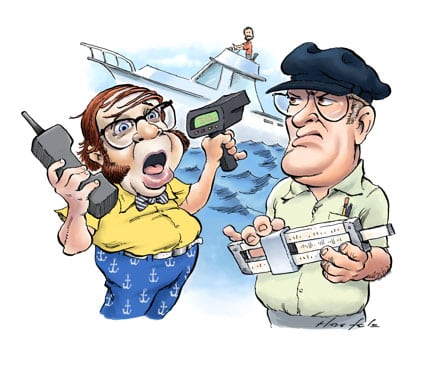
These days, it seems that yacht design is too often focused on flash. There was a time when yacht designers did more than ponder the color palette and the shape of hullside windows. Back in the day, yacht designers like my pal Dave Martin ciphered solutions to performance problems on a slide rule. Why, for example, is a boat sometimes slower south of the Mason-Dixon Line? Captain Ron would say, “Nobody knows,” but Dave does.
During Dave’s 50-plus-year career, his custom and production designs have tallied more than a thousand hull numbers. The technical papers and books he has penned have always been on my reading list. If you really want to understand boats, they should be on yours too. Recently, Dave offered me a peek at his upcoming book on performance. For a moment, I was transported back to a memory I’d repressed.
The draft included a paper Dave prepared in 1966 for the Society of Naval Architects and Marine Engineers. It explained nearly everything that can go wrong with a boat’s performance — and how to fix it. A follow-up of real-world performance problems included this awkward tidbit: Jay Coyle of Yachting tested the boat, and it was several knots slower than it should have been.
A very grumpy boatbuilder came to mind! I recalled the builder’s rep nervously watching me record the boat’s top end with a radar gun. It was 26 knots. Turning a sickly shade of gray, he pulled out the first cellphone I’d ever seen and dialed. “The boss says the boat goes 30 knots,” he mumbled.
“I recalled the builder’s representative nervously watching me record the boat’s top speed.”
I hadn’t known, until now, that the boat’s designer (Dave) heard from the grumpy boatbuilder minutes later. Lesser designers might have crumbled under the pressure, but Dave noodled a bit and came up with the answer.
A few knots are easy to misplace on sea trials. Conditions are rarely identical from one test to the next. Are the bottom and running gear clean? Are fuel, water and waste equal in weight? Is the owner’s stuff aboard? In addition to sea conditions, speed trials are about location, location, location. Due to a principle of fluid dynamics named for a fellow named Bernoulli, planing hulls in shallow water benefit from lift, while displacement hulls slow down. With luck, a boat might have one “perfect” sea trial: on launch day!
Dave’s design had made her predicted speed during sea trials on a winter day in the Northeast. Her diesels had been able to burp up every bit of their horsepower rating, inhaling the cold, dense air. Her propellers had been sized to bite into the chilled water at full rpm without causing water to boil on the low-pressure surfaces of the blades (cavitation).
Dave didn’t spin a color wheel to explain my speed-gun results. He worked his slide rule and explained that the Florida heat had sullied my sea trial numbers. And then the builder cooled down. Today, instead of gleaning numbers from a yacht designer, builders and skippers can push a button at the helm and see a ream of efficiency data from a computer. What do these numbers really mean?
Captain Ron would say, “Nobody knows.” Well, Dave does. And now you do too.









